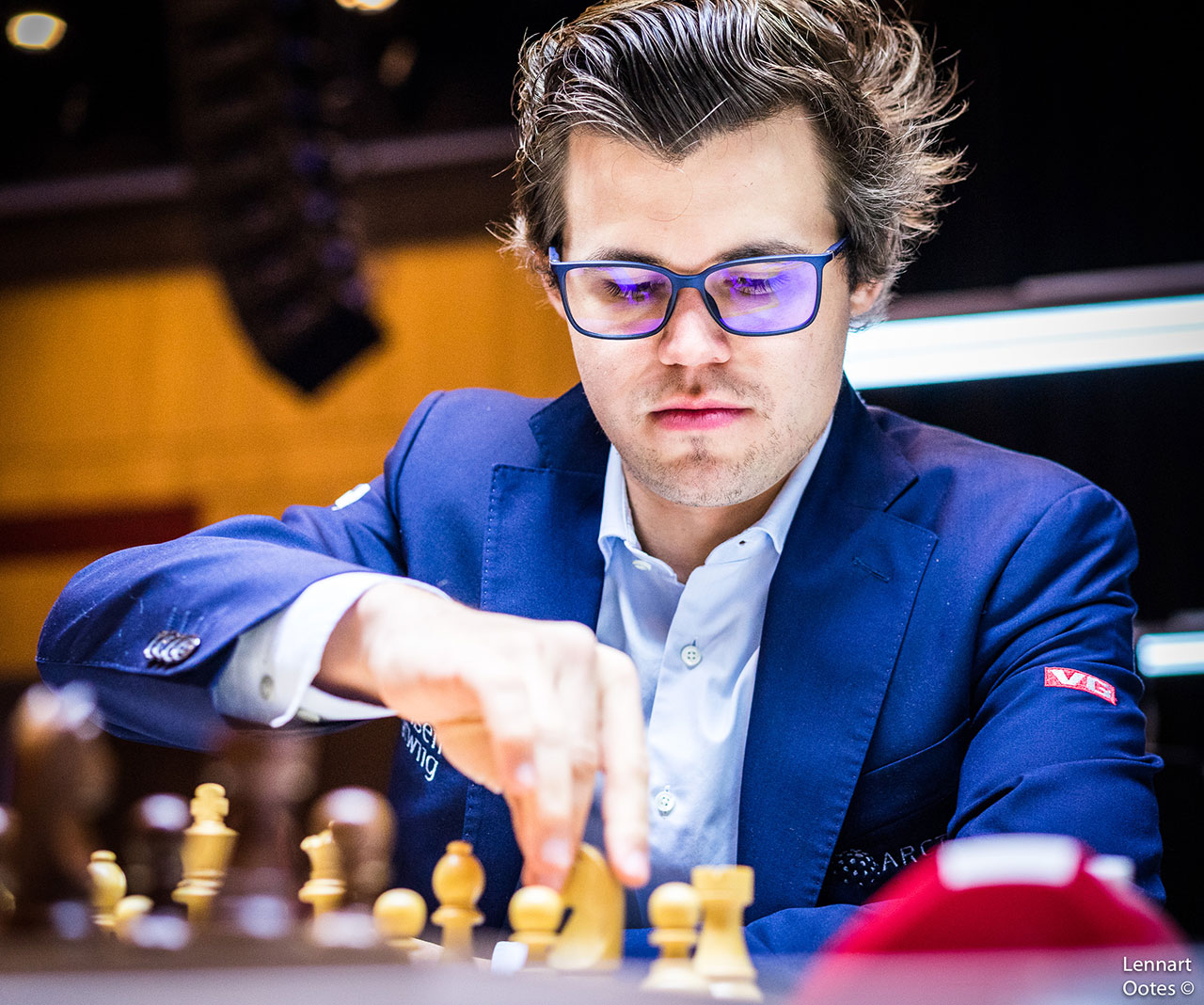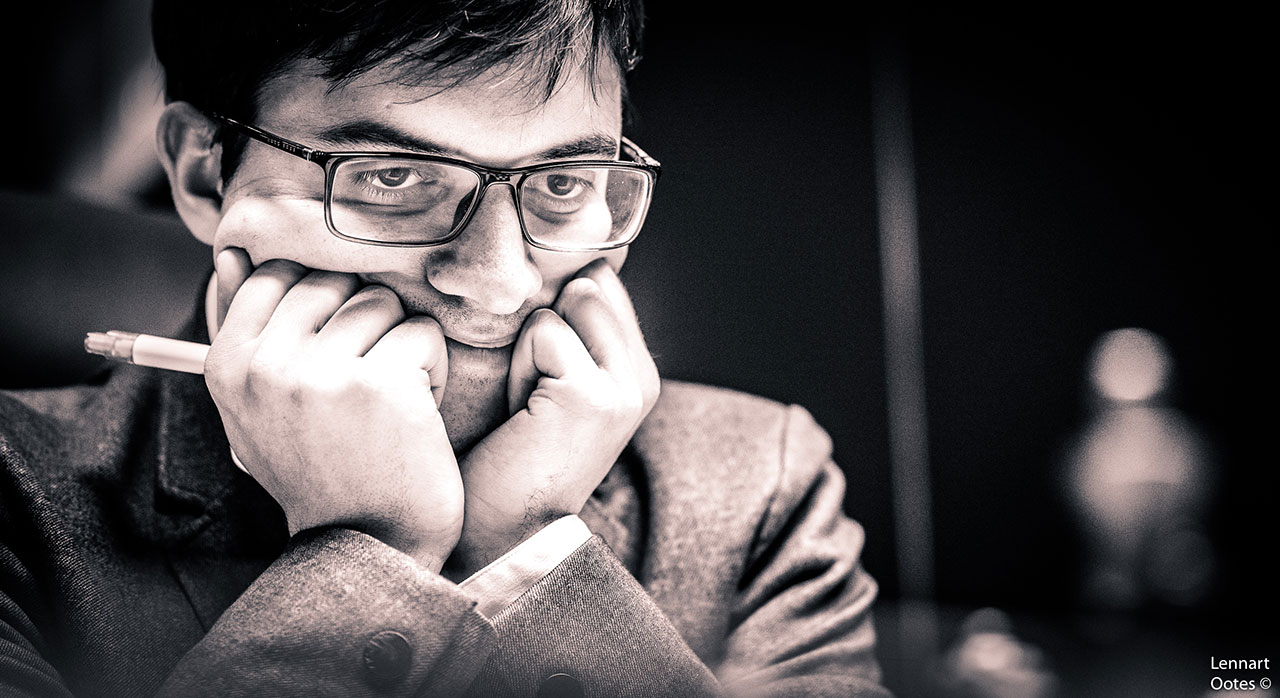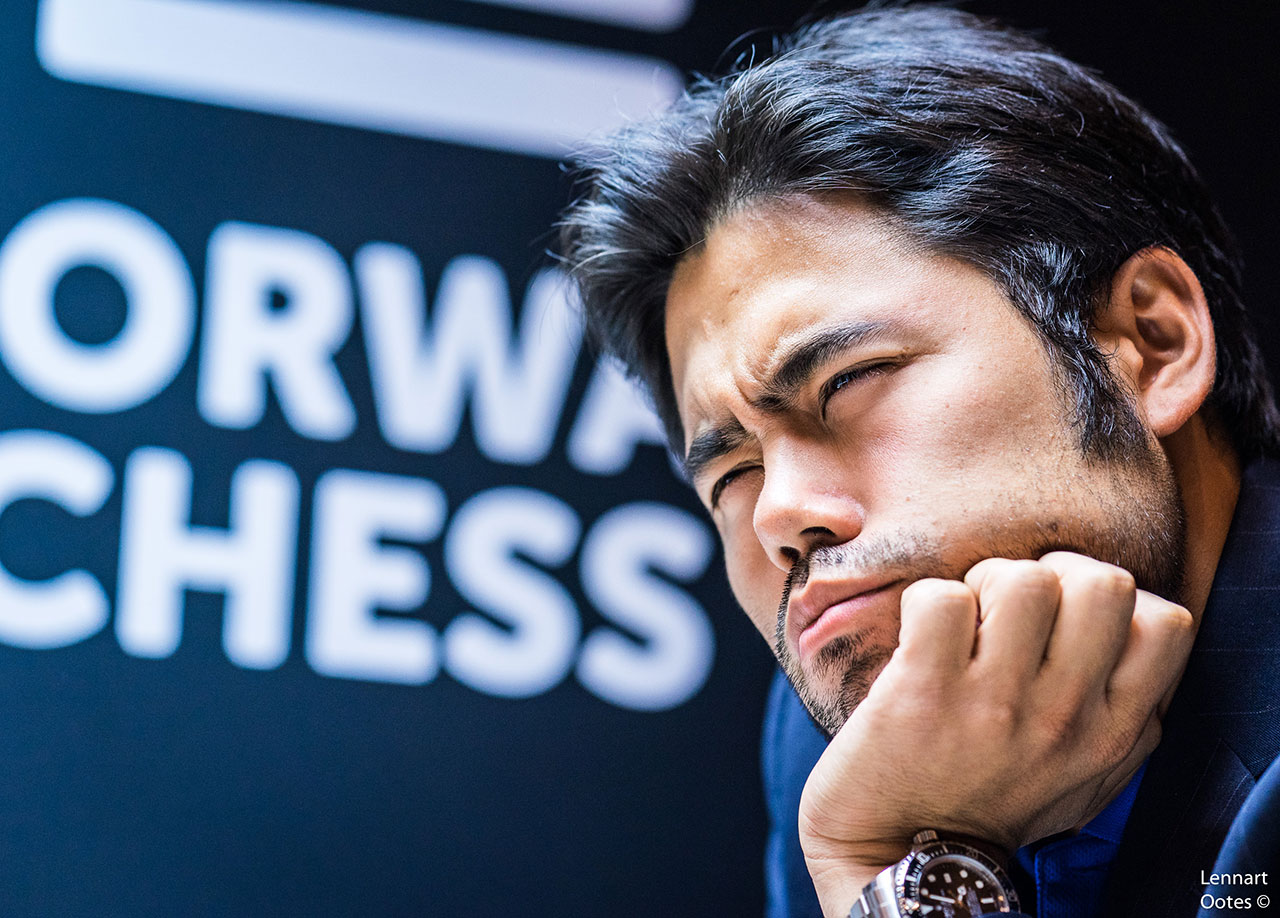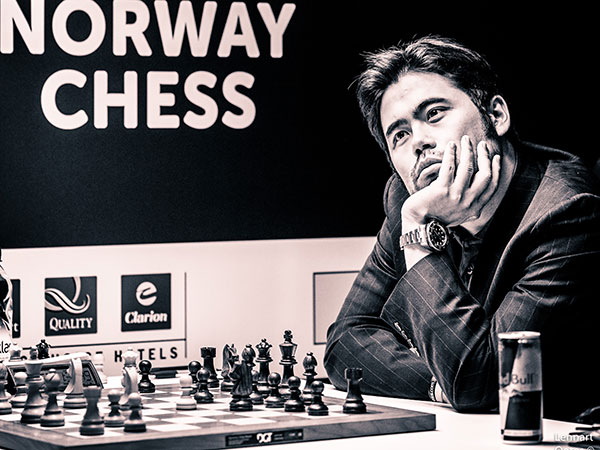Round five
All photos by Lennart Ootes
| Round 5: June 11, 2017 in Clarion Hotel Energy |
| Magnus Carlsen |
½-½ |
Anish Giri |
| Vishy Anand |
½-½ |
Wesley So |
| M. Vachier-Lagrave |
½-½ |
Levon Aronian |
| Sergey Karjakin |
½-½ |
Fabiano Caruana |
| Vladimir Kramnik |
½-½ |
Hikaru Nakamura |
All images in this article are high resolution. Click on them to see them full-sized.
The game between Magnus Carlsen and Anish Giri was a fairly tame Italian in which both played very proper, with careful piece maneuvers that aimed to neutralize more than to destabilize. Even the light tactics at the end with 31. Qb4 seemed so well under control that the flurry of exchanges that followed left little doubt as to the result. It was no big surprise though, as Carlsen was still licking his wounds from the previous round, while Giri was more than happy to take the draw with black against the world champion.

For aficionados of the Ruy Lopez Marshal, a new leaf was turned in one of the main lines (they almost all seem to be a main line nowadays) between Maxime Vachier-Lagrave and Levon Aronian. Aronian is a well-known expert of the defense and plays it regularly, though more often than not it seems more like his choice to guarantee a draw, unless White is so bold as to try for more, in which case: watch out. They repeated 19 moves of a previous game they played in…. Norway 2017. No, not a joke, this was their blitz game in the drawing of lots competition, which they also drew. It should be noted that the Marshall is sort of Sofia Rule proof, since with a regular 20+ moves of rote theory, if a draw is planned, it means 10 moves or fewer of actual play. You certainly wouldn’t get that with the St George Defense (1.e4 a6)!

Maxime Vachier-Lagrave was certainly not surprised by Aronian's choice of the Marshall as they repeated 20 moves from their blitz game in the Opening Ceremony competition
The game between Vishy Anand and Wesley So was also an Italian, and also a game from the Blitz event the previous week between Caruana and Aronian. There was a small twist, worth noting, and it was the conspicuous delay of d6 by Black. Instead he waited for White to commit 7.c3 and pushed 7…d5 straight away, equalizing as a result as well since White is one tempo behind in his piece development. The queens were off by move 15, and by move 23 it was a completely symmetrical rook and bishop endgame with nothing to grope for, and they shook hands on move 33.
In terms of theory, the game between Sergey Karjakin and Fabiano Caruana was certainly a surprise to viewers and pundits. Not only did Caruana swap his Berlin for the Petroff with black, but they followed a line that has barely been taken out of the theoretical basement in years, with the most recent essays by Nisipeanu in the 2015 World Cup. That might not seem so long ago, prior to that, for top players, you need to go back to 2007, with Ivanchuk and Kramnik giving it a one-time spin.

Fabiano was dying to try out a novelty he had prepared, involving an exchange sac, and after careful analysis, Sergey took up the gauntlet
Caruana had a nifty exchange sac in mind to explain his desire to roll back the clocks, and Karjakin was willing to take up the gauntlet, after making sure this would have a better fate than Carlsen when Aronian sacked his exchange. The Russian gave it back at the right moment, and emerged in a rook endgame up a pawn, but with strong drawing chances for Black. Caruana’s technique passed the test, and they drew after 73 moves.

Sergey Karjakin was in form and replied well to Fabiano's novelty. He came out ahead, but was unable to do more.
Sergey Karjakin vs Fabiano Caruana
| Replay and check the LiveBook here |
Please, wait...
1.e4 e5 2.Nf3 Nf6 3.Nxe5 d6 4.Nf3 Nxe4 5.d4 d5 6.Bd3 Bd6 7.0-0 0-0 8.c4 c6 9.Re1 Bf5 10.Qb3 Qd7 11.Nc3 Nxc3 12.Bxf5 Qxf5 13.Qxb7 13...Ne4N 13...Qd7 14.Qxd7 Nxd7 15.c5 Bxh2+ 16.Nxh2 Ne4 17.Bf4 Rfe8 18.f3 14.Qxa8 Qd7! 15.cxd5 Nf6! 16.Re3! Nxd5 17.Rb3! Nb4! 18.Rxb4! 18.a3? Nc2 19.Rb1 Qe6 20.Bf4! 20.Qb7? Nxd4! 21.Re3 Nxf3+ 22.gxf3 Qg6+ 20...Bxf4 21.Qb7 18...Bxb4 19.Be3! Bd6! 20.d5! c5! 21.b4! cxb4 22.Rc1 Rd8 23.Qxa7 Qxa7 24.Bxa7 Nd7 25.Bd4 Ra8 26.Kf1 Ra5 27.Rc8+ Bf8 28.d6 Rd5 29.Ne5 Nxe5 30.Bxe5 f6 31.Bg3 Kf7 32.Rb8 Bxd6 33.Bxd6 Rxd6 34.Rxb4 Rd2 35.a4 Ra2 36.h4 h5 37.g3 Kg6 38.Rf4 Kf7 39.Ke1 Ke6 40.Rb4 Kf5 41.Kd1 Ke5 42.Ke1 Kf5! 43.Kf1 Kg6 44.Rc4 Kh6 45.Rf4 Kg6 46.Ke1 Kf7 47.Kf1 Kg6! 48.Kg2 Ra3 49.Kh3 Ra2 50.g4 Ra3+ 51.f3 hxg4+ 52.Kxg4 Ra1 53.Rc4 Ra2 54.h5+ Kh6 55.f4 Rg2+ 56.Kf5 Rh2 57.Ke6 Rxh5 58.f5 Rh1 59.Rc5 Kg5 60.Kf7 Rh7 61.a5 g6+ 62.Ke6 Rh1 63.a6 Ra1 64.fxg6+ Kxg6 65.Rc6 f5 66.Kd6 Kg5 67.Kc7 f4 68.Kb7 f3 69.Rc2 Kf4 70.a7 Kg3 71.a8Q Rxa8 72.Kxa8 f2 73.Rxf2 Kxf2 ½–½ - Start an analysis engine:
- Try maximizing the board:
- Use the four cursor keys to replay the game. Make moves to analyse yourself.
- Press Ctrl-B to rotate the board.
- Drag the split bars between window panes.
- Download&Clip PGN/GIF/FEN/QR Codes. Share the game.
- Games viewed here will automatically be stored in your cloud clipboard (if you are logged in). Use the cloud clipboard also in ChessBase.
- Create an account to access the games cloud.
| Karjakin,S | 2781 | Caruana,F | 2808 | ½–½ | 2017 | C42 | Altibox Norway Chess 2017 | 5 |
Please, wait...
The battle between Kramnik and Nakamura was also chosen as the game of the day by Tiger Hillarp-Persson, and though also a draw as they all were, it was a good fight between the two players as usual.

An excellent fight once again, and Nakamura maintains the lead at the midway point
Vladimir Kramnik vs Hikaru Nakamura (annotated by GM Tiger Hillarp-Persson)

| Replay and check the LiveBook here |
Please, wait...
- Start an analysis engine:
- Try maximizing the board:
- Use the four cursor keys to replay the game. Make moves to analyse yourself.
- Press Ctrl-B to rotate the board.
- Drag the split bars between window panes.
- Download&Clip PGN/GIF/FEN/QR Codes. Share the game.
- Games viewed here will automatically be stored in your cloud clipboard (if you are logged in). Use the cloud clipboard also in ChessBase.
- Create an account to access the games cloud.
Standings after five rounds

(click image for full size)
Pairings and results of Norway Chess 2017
| Round 1: June 6, 2017 in Clarion Hotel Energy |
| Hikaru Nakamura |
1-0 |
Anish Giri |
| Levon Aronian |
½-½ |
Fabiano Caruana |
| Magnus Carlsen |
½-½ |
Wesley So |
| M. Vachier-Lagrave |
½-½ |
Vishy Anand |
| Vladimir Kramnik |
½-½ |
Sergey Karjakin |
| Round 2: June 7, 2017 in Clarion Hotel Energy |
| Hikaru Nakamura |
½-½ |
Levon Aronian |
| Anish Giri |
½-½ |
Sergey Karjakin |
| Fabiano Caruana |
½-½ |
Magnus Carlsen |
| Wesley So |
½-½ |
M. Vachier-Lagrave |
| Vishy Anand |
0-1 |
Vladimir Kramnik |
| Round 3: June 8, 2017 in Clarion Hotel Energy |
| Levon Aronian |
½-½ |
Anish Giri |
| Magnus Carlsen |
½-½ |
Hikaru Nakamura |
| M. Vachier-Lagrave |
½-½ |
Fabiano Caruana |
| Sergey Karjakin |
½-½ |
Vishy Anand |
| Vladimir Kramnik |
½-½ |
Wesley So |
| Round 4: June 10, 2017 in Clarion Hotel Energy |
| Hikaru Nakamura |
1-0 |
M. Vachier-Lagrave |
| Anish Giri |
1-0 |
Vishy Anand |
| Levon Aronian |
1-0 |
Magnus Carlsen |
| Fabiano Caruana |
½-½ |
Vladimir Kramnik |
| Wesley So |
½-½ |
Sergey Karjakin |
| Round 5: June 11, 2017 in Clarion Hotel Energy |
| Magnus Carlsen |
½-½ |
Anish Giri |
| Vishy Anand |
½-½ |
Wesley So |
| M. Vachier-Lagrave |
½-½ |
Levon Aronian |
| Sergey Karjakin |
½-½ |
Fabiano Caruana |
| Vladimir Kramnik |
½-½ |
Hikaru Nakamura |
| Round 6: June 12, 2017 in Clarion Hotel Energy |
| Hikaru Nakamura |
|
Sergey Karjakin |
| Anish Giri |
|
Wesley So |
| Levon Aronian |
|
Vladimir Kramnik |
| Fabiano Caruana |
|
Vishy Anand |
| Magnus Carlsen |
|
M. Vachier-Lagrave |
| Round 7: June 14, 2017 in Stavanger Concert Hall |
| Wesley So |
|
Fabiano Caruana |
| Vishy Anand |
|
Hikaru Nakamura |
| M. Vachier-Lagrave |
|
Anish Giri |
| Sergey Karjakin |
|
Levon Aronian |
| Vladimir Kramnik |
|
Magnus Carlsen |
| Round 8: June 15, 2017 in Stavanger Concert Hall |
| Hikaru Nakamura |
|
Wesley So |
| Anish Giri |
|
Fabiano Caruana |
| Levon Aronian |
|
Vishy Anand |
| Magnus Carlsen |
|
Sergey Karjakin |
| M. Vachier-Lagrave |
|
Vladimir Kramnik |
| Round 9: June 16, 2017 in Stavanger Concert Hall |
| Fabiano Caruana |
|
Hikaru Nakamura |
| Wesley So |
|
Levon Aronian |
| Vishy Anand |
|
Magnus Carlsen |
| Sergey Karjakin |
|
M. Vachier-Lagrave |
| Vladimir Kramnik |
|
Anish Giri |
Links
You can use ChessBase 14 or any of our Fritz compatible chess programs to replay the games in PGN. You can also download our free Playchess client, which will in addition give you immediate access to the chess server Playchess.com.






























